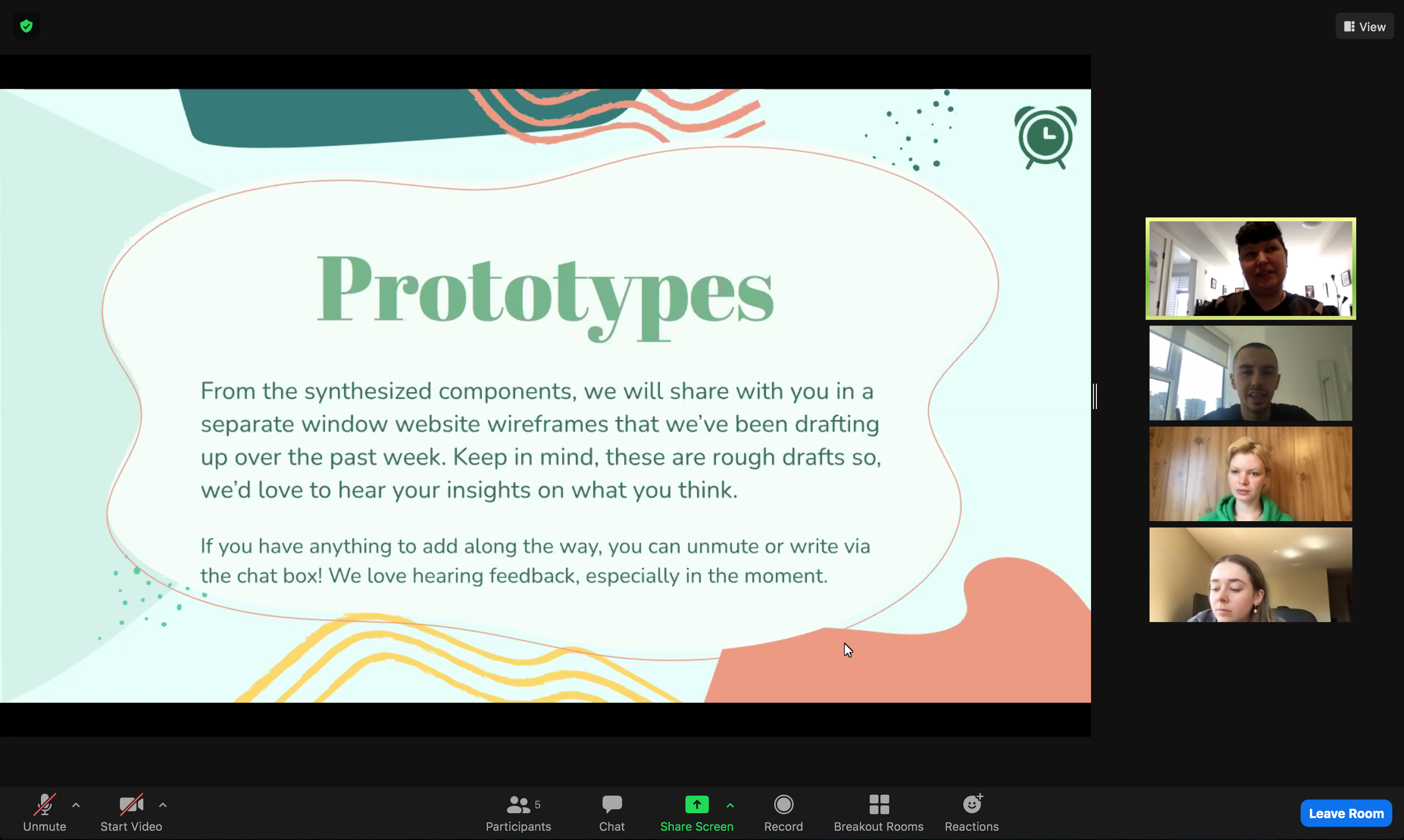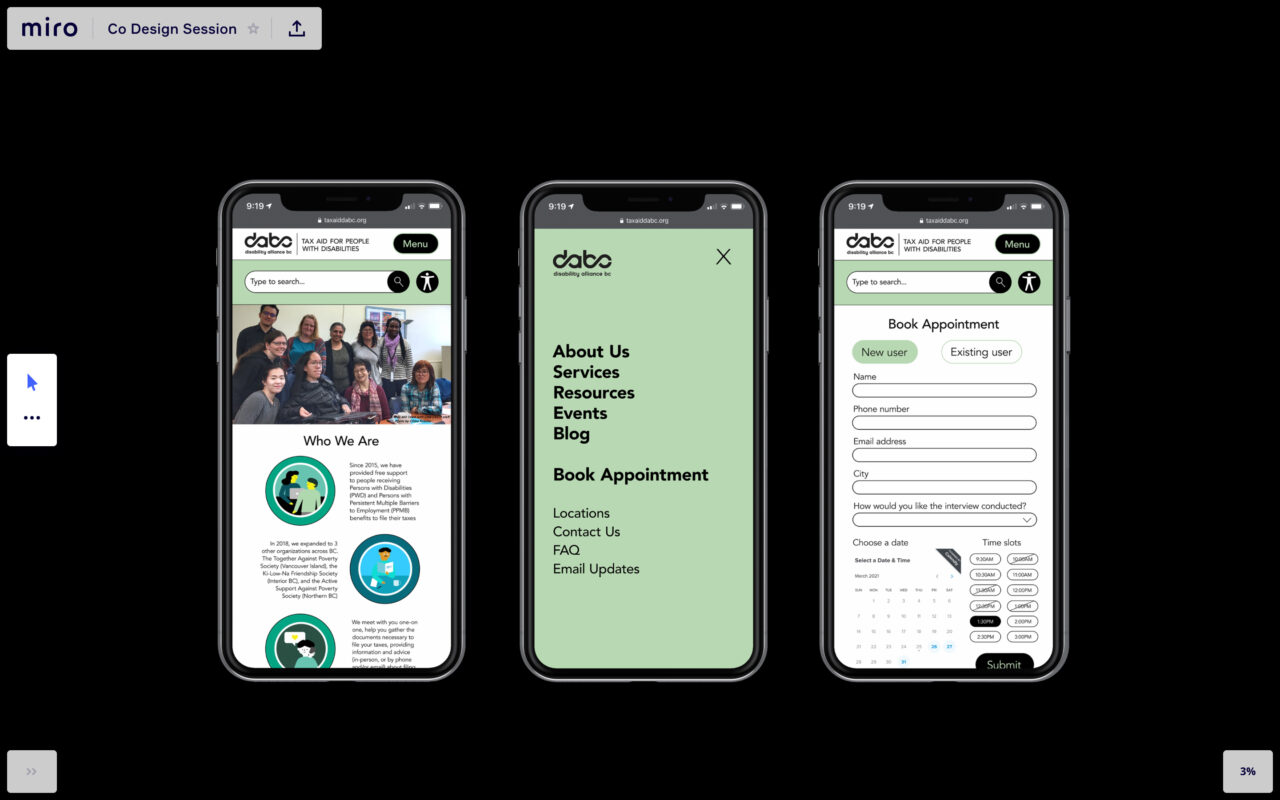Design Students and Disability Alliance BC Community Members Co-Create in Online Collaboration

Posted on
ECU and DABC participants connected via video throughout the spring to address issues of digital access and inclusion.
A program connecting ECU design students and Disability Alliance BC (DABC) participants for collaborative design projects went online this year, with COVID making in-person meetings impossible.
The Spring 2021 semester saw project lead and ECU faculty member Eugenie Cheon’s COMD310 Communication Design class addressing an issue of digital access and inclusion by proposing redesigns for one of DABC’s websites, which focuses on the Tax Aid program. And while some of the benefits of in-person collaboration were sorely missed, Eugenie says participants eagerly embraced the online format.
“What’s great about our students and our DABC co-creators is that they’re so resilient and adaptive to what is needed to work around these challenges,” Eugenie says. “That’s been so fascinating for me: how everybody’s willing to work with what we have, and being really humble about not-knowing, not being experts, and navigating it all together.”
The program began in Fall of 2019, when DABC contacted the Health Design Lab (HDL) at Emily Carr with a proposal to bring design students on board to help tackle communication design challenges identified by staff, volunteers and clients of DABC. To this end, students are partnered into groups with DABC community members to engage in a series of co-creative workshops. Through co-designed creative activities and shared storytelling, the teams work to build relationships and develop insights into the lives of people with disabilities. Focusing on a new project each semester, the groups ultimately make design recommendations to DABC.
“We hoped to shift perceptions of disability, so our young designers saw people with disabilities as experts in, and advocates for, their experiences,” Eugenie wrote in a 2020 article in Transition Magazine co-authored by Lisa Boulton, design research associate with the HDL.

A journey map, developed by one of the groups in the spring, 2021, COMD310/DABC collaborative website redesign project.
No Such Thing as Universal Design
As with previous years, 2021 participants took on a series
of co-design activities over five workshops. The groups aimed to develop
a detailed picture of how the DABC’s Tax Aid website could better
support the people who use it. Activities included storytelling,
knowledge sharing, ideation and much more, which afforded richer
accounts about the real users and their contexts.
Participants walked students through how they navigate and experience different web spaces, including the DABC website. By taking virtual journeys through various web-related scenarios, groups were granted yet another view on how the DABC site was helping or hindering users.
Final design recommendations were presented to the DABC community in the last celebratory session as were some of the lessons participants and students learned along the way.
“At the end of each group’s presentation, participants and other DABC members joined in to share their feedback and their experiences of the process,” Eugenie says. “Overall, it went great! It really felt like we all bonded over the semester and got to celebrate.”
Redesign suggestions for the website ranged from the subtle — such as changes to a font or to key colours, or the inclusion of bigger buttons and calls-to-action — to a wholesale restructuring of the website. But according to participants, the most important outcomes lie outside the final designs.
“Through this project, we hoped participants would recognize the potential of inclusive design to empower individuals, create positive experiences, build strong communities and transform the face of DABC,” Myung Lee, DABC accessibility project manager, told Lisa and Eugenie for their 2020 article.

An overview of the workflow of one group's collaborative website redesign project.
Students in the Spring 2021 COMD310 class say those lessons came across loud and clear. Design student Anne Lee says she quickly realized there is no such thing as universal design. But if a designer aims to see the world through the eyes of others, they’re on the road making a meaningful difference for real people.
“My experience with participatory design allowed me to take a step back and look at different perspectives,” Anne says. “It opened up my own bias towards new ways of understanding and continuously reflecting on how to make design more inclusive and accessible. Designing to me is now more than just designing for myself or for a client — it’s expanding my design practice to help others and finding ways to include all types of people.”
Design student Alexandra Markic says she found herself becoming more personally engaged as her focus shifted away from creating a product and toward learning about her co-creators.
“Sometimes, when you’re working on creating an object, you
tend to focus on solving a problem instead of looking at the actual
people involved,” she says. “So, building those relationships and
learning about the people I was working with encouraged me to work
harder to ensure their voices and perspectives were reflected and
included throughout the design process.”

A mock-up of the mobile web redesign proposed by one group of participants in the spring, 2021, COMD310/DABC co-creation project.
A More Meaningful Existence
Conducting the course online presented both challenges and opportunities, notes Eugenie.
Barriers to human contact — which is of primary importance in participatory design — are real in online forums, she says. On the flip side, online classes can sometimes benefit people with disabilities who encounter barriers when moving through public spaces.
Design student Cici Qiu, who participated in the Spring 2021 COMD310 course, says she felt no disadvantage whatsoever having taken the class online. Focusing on relationship-building made the experience feel consequential, Cici reports, regardless of whether it was all conducted through screens.
“I think participatory design creates an opportunity to connect with people in the community,” she says. “Designing for inclusivity also gives a product, space or experience a more meaningful existence in the world. Although it was conducted virtually, our dialogues stimulated senses and new perspectives when ideas intertwined in the design process.”
Cici’s observation hits on a key point, first identified by Eugenie and Lisa after the 2020 edition of the program: that DABC is “more than just a place that provides professional assistance. It is a community that values playfulness and human connection.”

Students and DABC community members collaborate on a website redesign in spring, 2021.
Participatory design is an ideal way to engage with non-profit, human-centric organizations like DABC, Eugenie tells me. As a process, it’s not about designers taking sole charge of design, she says. Instead, it’s about ensuring the process of design engages from the beginning with the lived experience of those communities it is meant to serve.
“It’s really about creating a safe space and the conditions for communities to have a voice and freely express their ideas, their daily lives, their histories,” she says. “Those areas, we, as designers, don’t really know. We haven’t lived their lives. We oftentimes stress the importance of being empathetic in design, how do we really do that when we don’t know what others have experienced or been through? The work students do in this course gives them a chance to elicit those insights.”
This aim fits into the broader approach Eugenie hopes to convey to students through working with DABC: to broaden the horizon of what design practices can include. Design can also be about creating scaffolds and tools to unlock people's latent and tacit knowledge — knowledge that can’t be easily accessed or expressed — bringing about nuanced and complex new understandings.
In this way, the outcome of the COMD310 course isn’t the creation of a defined object or asset, Eugenie continues. Rather, it’s about “creating accessible and inclusive tools, engaging with real audiences/users, and amplifying the diversity and richness of disability-led ways of knowing through design.”
--
To learn more about DABC, go to disabilityalliancebc.org. for information on ECU’s Communication Design Major, visit ecuad.ca.